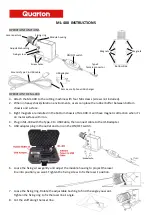
USER MANUAL | ICOS | INSTRUCTIONS | UM/ICOS-EN REV. B.2
69
ABB-LGR’s Off-Axis Integrated-Cavity Output Spectroscopy
(Off-Axis ICOS)
Off-Axis ICOS uses a high-finesse optical cavity as an absorption cell as shown in Figure 52.
Unlike multi-pass detectors, which are typically limited to path lengths of less than two
hundred meters, an Off-Axis ICOS absorption cell effectively traps the laser photon so that,
on average, they make thousands of passes before leaving the cell.
As a result, the effective optical path length may be several thousands of meters using
high-reflectivity mirrors and thus the measured absorption of light after it passes through
the optical cavity is significantly enhanced. For example, for a cell composed of two
99.99% reflectivity mirrors spaced by 25 cm, the effective optical path length is 2500
meters.
Figure 52: Schematic Diagram of an Off-Axis ICOS Analyzer
Because the path length depends only on optical losses in the cavity and not on a unique
beam trajectory (like conventional multi-pass cells or cavity-ring-down systems), the
optical alignment is very robust allowing for reliable operation in the field. The effective
optical path length is determined routinely by simply switching the laser off and measuring
the necessary time for light to leave the cavity (typically tens of microseconds).
As with conventional tunable-laser absorption-spectroscopy methods:
The wavelength of the laser is turned over a selected absorption feature of the
target species.
The measured absorption spectra is recorded and used to determine a quantitative
measurement of mixing ratio directly and without external calibration when
combined with the recorded:
o
Measured gas temperature and pressure in the cell
o
Effective path length
o
Known line strength
















































